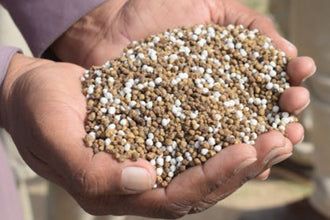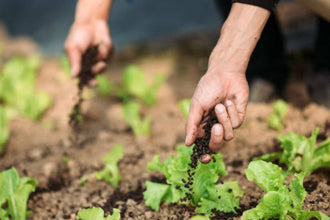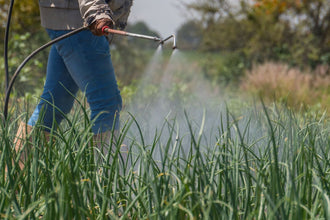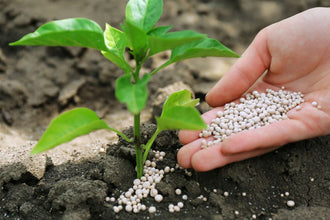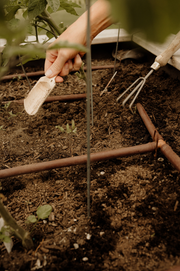
Granular fertilizer has been helping gardeners grow amazing plants for years, but liquid fertilizers keep getting more popular. You've probably stood in the garden center wondering which one to pick. Both bags and bottles promise healthier plants and better harvests. So which one actually works better?
The truth is, it depends on what you're growing and how you like to garden. Some plants love the steady feeding that granular fertilizer provides. Others do better with the quick boost from liquid fertilizer. Your soil, your schedule, and even the weather all play a part in which one works best.
Most gardeners don't realize how different these two types really are. Granular fertilizer works like a slow cooker, releasing nutrients gradually over time. Liquid fertilizer is more like a microwave, giving plants nutrients they can use right away. Both methods feed your plants, but they do it in completely different ways.

How Granular Fertilizer Feeds Your Plants
Granular fertilizer sits in your soil and slowly breaks down over weeks or months. Water helps dissolve the tiny pellets, and soil bacteria work to turn the nutrients into forms your plants can actually use. This process takes time, but it creates a steady supply of food for your plants.
Think of granular fertilizer like a time-release vitamin. The pellets are designed to dissolve at different rates, so your plants get fed consistently instead of getting one big meal and then going hungry. This steady feeding helps plants grow more evenly and reduces stress.
Temperature makes a big difference in how fast granular fertilizer works. Hot summer soil breaks down the pellets faster than cold spring soil. This actually works out pretty well because plants need more food when they're growing fast in warm weather.
Why Slow Release Actually Works Better
Most granular fertilizers mix fast-acting nutrients with slow-release ones. The fast part gives plants a quick snack right after you apply it. The slow part keeps feeding them for months afterward. This combination prevents the ups and downs that can hurt plant growth.
The coating on each pellet controls how fast nutrients get released. Some use special plastics that let nutrients seep out slowly. Others use natural materials that break down at steady rates. Either way, you get consistent feeding without having to remember to fertilize every week.
Your soil helps store the nutrients too. Clay and organic matter grab onto the fertilizer and release it as plants need it. This natural system prevents nutrients from washing away and keeps plants fed even during dry spells.
The Good and Bad of Using Granular Fertilizer
Granular fertilizer saves you time because you only need to apply it a few times per year. Most types keep working for 2 to 3 months, which means less work for you. You can actually see where you've spread it, so you won't miss spots or accidentally put too much in one area.
Here are the main benefits:
-
Lasts for months with one application
-
Easy to see where you've applied it
-
Won't burn plants if you use the right amount
-
Works well for large areas like lawns
-
Stores easily without going bad
The downsides include:
-
Takes longer to see results
-
Doesn't work well in very cold soil
-
Hard to adjust if plants need different nutrients
-
Can be messy to apply on windy days
How Liquid Fertilizer Gives Quick Results
Liquid fertilizer delivers nutrients that plants can use within hours. The nutrients are already dissolved, so plant roots don't have to wait for soil bacteria to break anything down. This speed makes liquid fertilizer perfect when you need to fix problems fast or give plants a quick boost.
You can also spray liquid fertilizer directly on plant leaves. Plants can absorb nutrients through their leaves just like they do through their roots. This method works especially well for fixing nutrient problems that might be hard to solve through the soil.
The biggest advantage of liquid fertilizer is control. You can make it stronger or weaker depending on what your plants need. You can also change the mix as your plants go through different growth stages. Need more nitrogen for leafy growth? Easy. Want more phosphorus for better flowers? Just switch formulas.
Getting Nutrients to Plants Fast
Plants start using nutrients from liquid fertilizer almost immediately. This quick response helps when you're dealing with sick plants or trying to push growth before a specific deadline. Container plants especially benefit from liquid feeding because their roots can't search for nutrients like plants in the ground can.
The nutrients in liquid fertilizer are already in the exact forms that plant roots recognize. There's no waiting for soil chemistry to convert them. This direct delivery system works great in situations where soil conditions might tie up nutrients and make them unavailable to plants.
You can target exactly where plants need the most help. Spray it right around the root zone or even on the leaves themselves. This precision reduces waste and gets nutrients where they'll do the most good.
When Liquid Fertilizer Works Best
Liquid fertilizer adapts to almost any growing situation. Container gardens, hanging baskets, and houseplants all do well with liquid feeding because you control exactly how much each plant gets. This control becomes really important when you're growing different types of plants together.
Here's where liquid fertilizer shines:
-
Container and indoor plants
-
Quick fixes for nutrient problems
-
Plants going through rapid growth
-
Situations where you need precise control
-
Hydroponic and soilless growing systems
The flexibility of liquid fertilizer lets you adjust your feeding program as seasons change. Spring feeding can focus on getting plants started. Summer applications can help plants handle stress. Fall feeding can help plants prepare for winter.
Comparing Costs and Time Investment
Granular fertilizer usually costs less per application than liquid types. One bag can last most home gardeners an entire season. You spend less time applying it because each treatment lasts for months instead of weeks.
Liquid fertilizer requires more frequent buying and mixing. You'll make more trips to the store and spend more time preparing applications. However, the precise control and fast results can make the extra cost worth it for certain plants or situations.
The real cost difference shows up over time. Granular fertilizer front-loads your investment but spreads the cost over months. Liquid fertilizer spreads the cost out but adds up to more money and time by the end of the season.
Hidden Costs You Should Know About
Equipment needs are different for each type. Granular fertilizer works with simple spreaders or even your hands. Liquid fertilizer might need sprayers, mixing containers, and measuring tools. These extras add to your initial investment.
Storage requirements vary too. Granular fertilizer keeps well in basic containers for years. Liquid concentrates might need special storage conditions and can go bad faster once you mix them up.
Weather can affect your costs. Heavy rain right after applying liquid fertilizer might wash it away before plants can use it. Granular fertilizer stays put better during storms, so you lose less of your investment to bad weather.
Impact on Soil Health Over Time
Granular fertilizer often helps build better soil because it feeds the beneficial bacteria and fungi that plants depend on. These soil organisms break down the fertilizer and create a healthier growing environment. This process improves your soil year after year.
Many granular fertilizers contain organic materials that add to soil structure. As these materials break down, they help soil hold water better and create spaces for air to reach plant roots. This soil improvement is an investment that pays off for years.
Liquid fertilizer can bypass the soil entirely, especially when you spray it on leaves. While this gives quick results, it doesn't do much to improve soil health over time. However, liquid organic fertilizers applied to the soil can still feed beneficial soil organisms.
Environmental Considerations
Both fertilizer types can affect water quality if not used carefully. Granular fertilizer releases nutrients slowly, which gives plants more time to absorb them before they can wash away. This gradual release reduces the risk of nutrient pollution in waterways.
Liquid fertilizer creates higher concentrations of nutrients right after application. This concentration increases the chance of nutrients washing into storm drains or groundwater, especially during heavy rain or overwatering.
Timing your applications matters more with liquid fertilizer. Apply it right before rain, and you might lose most of it to runoff. Granular fertilizer gives you more flexibility because it releases nutrients gradually regardless of weather conditions.
Choosing the Right Type for Your Garden
Your plants and growing conditions should guide your fertilizer choice. Vegetable gardens and annual flowers often respond well to liquid feeding because they grow fast and need lots of nutrients. Trees, shrubs, and perennial plants usually do better with granular fertilizer that provides steady nutrition over long periods.
Soil type plays a huge role in which fertilizer works best. Clay soil holds nutrients well, making granular fertilizer efficient and long-lasting. Sandy soil drains fast, which can wash away liquid fertilizer before plants use it. Slow-release granular products work better in sandy conditions.
Garden size and your available time determine what's practical. Small gardens and container plants benefit from the precision of liquid feeding. Large lawns and landscape beds work better with granular applications that cover lots of area without much labor.
Smart Strategies That Use Both Types
Many experienced gardeners use both types at different times. Granular fertilizer provides the foundation of plant nutrition throughout the season. Liquid fertilizer handles specific needs like transplant shock, growth spurts, or nutrient deficiencies that pop up.
Spring applications of granular fertilizer set plants up for success all season long. Mid-season liquid feeding can address problems or boost performance when plants need extra help. This combination approach gives you the benefits of both systems without the drawbacks of relying on just one.
Fall fertilizing strategies differ by type. Granular fertilizer applied in fall feeds roots and gets plants ready for next spring's growth. Liquid fertilizer works better for late-season feeding that helps plants store energy for winter.
Fancy Chicken Organic Pelletized Chicken Manure: The Best of Both Worlds
Bridging the Gap Between Granular and Liquid Benefits
Fancy Chicken organic pelletized chicken manure offers a unique solution that captures many advantages of both granular and liquid fertilizers. These concentrated pellets provide the long-lasting nutrition of traditional granular fertilizer while delivering nutrients in forms that plants can access more readily than standard synthetic granules.
The pelletized form makes this organic fertilizer incredibly convenient to apply and store, eliminating the mess and odor issues that keep many gardeners away from fresh chicken manure. Each pellet breaks down gradually over 2-3 months, providing steady nutrition without the boom-and-bust cycles that stress plants and waste money.
Unlike synthetic granular fertilizers that rely on chemical coatings, Fancy Chicken pellets use natural decomposition processes. Soil microbes break down the organic matter at rates that match plant needs, creating a naturally timed release system that's more responsive to growing conditions than artificial slow-release mechanisms.
Why Organic Pellets Outperform Standard Granular Options
Fancy Chicken pelletized manure delivers superior soil improvement that synthetic granular fertilizers simply can't match. While feeding your plants, these pellets simultaneously build soil biology and structure for long-term garden health.
Advantages over synthetic granular fertilizers:
-
Higher nutrient availability without chemical processing
-
Feeds beneficial soil microbes that improve plant immunity
-
Improves soil structure and water retention naturally
-
Contains balanced NPK plus essential micronutrients
-
Won't burn plants even with generous application
-
Breaks down faster than standard organic granules
The organic matter in Fancy Chicken pellets creates lasting soil improvements that synthetic options can't provide. As the pellets decompose, they add humus that helps sandy soils hold water and clay soils drain better. This soil conditioning effect builds garden health that improves year after year.
Faster Results Than Traditional Organic Granular Fertilizer
Most organic granular fertilizers take weeks to show results as they slowly decompose in soil. Fancy Chicken pellets work much faster because the composting and pelletizing process has already begun breaking down the organic matter. Plants start benefiting within days of application.
Timeline advantages:
-
Visible plant response within 7-10 days
-
Full nutrient release over 8-12 weeks
-
Continues improving soil for months after pellets disappear
-
Works in cooler soil better than raw organic materials
This faster response time means you get quicker feedback on your fertilizing program. You'll see greener foliage and stronger growth soon after application, giving you confidence that your plants are getting proper nutrition without waiting weeks to evaluate results.
Application Flexibility That Beats Standard Granules
Fancy Chicken pellets offer more application flexibility than typical granular fertilizers. The uniform pellet size ensures even distribution whether you're using a spreader or applying by hand. The organic composition means you can be generous with application rates without fear of burning plants.
Work the pellets into soil around established plants or broadcast them over larger areas. Unlike synthetic granules that can create hot spots if unevenly distributed, these organic pellets provide gentle, consistent feeding even if application isn't perfectly uniform.
The pellets store easily without special conditions and won't lose potency like some liquid concentrates. This stability makes bulk purchasing economical and ensures consistent results throughout the growing season. Most gardeners find that spring and mid-summer applications provide all the nutrition their gardens need for peak performance.
Make the Smart Choice for Your Garden Success
Your garden's success comes down to matching the right fertilizer type with your specific situation. Granular fertilizer offers convenience and builds soil health for most gardens. Liquid fertilizer provides precision and quick results when you need immediate plant response.
The best approach combines understanding your plants' needs with your own gardening style. Consider your soil type, garden size, and how much time you want to spend on maintenance. Both granular and liquid fertilizers can produce amazing results when you use them correctly.
Start with granular fertilizer as your main feeding program, then add liquid applications for special situations. This strategy gives you the reliability of slow-release feeding plus the flexibility to handle problems as they come up. Your plants will reward you with healthier growth and better production all season long.




